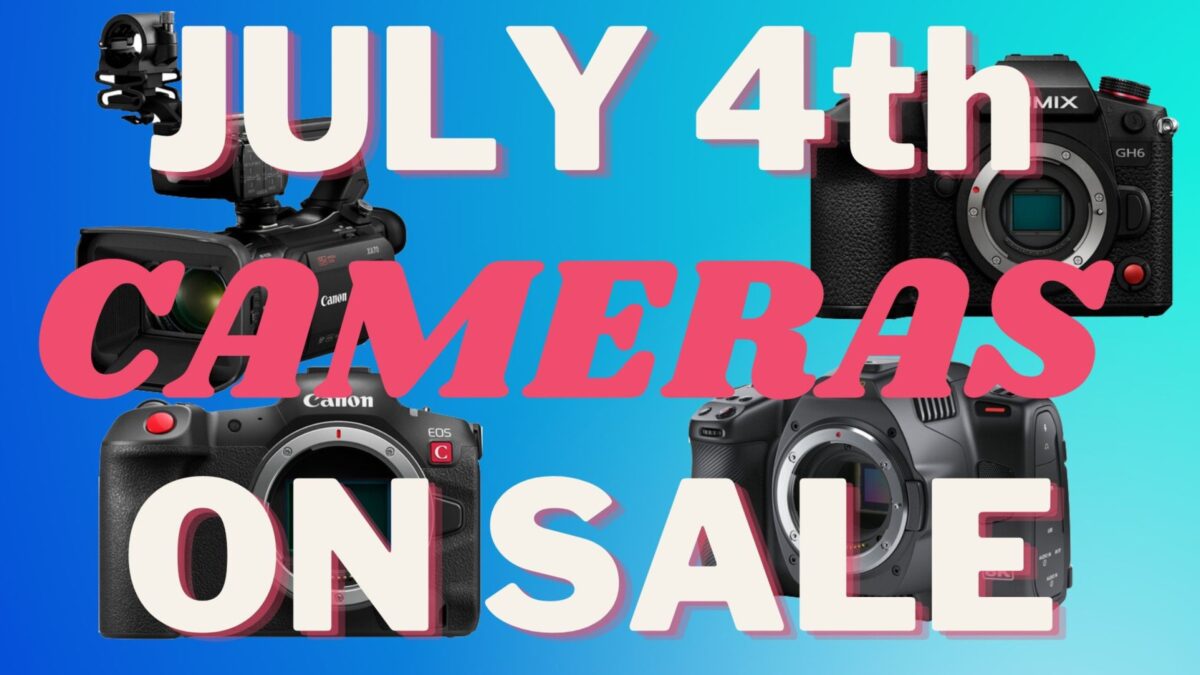
This July 4th, our “Deals of the Week” give your toolkit a camera upgrade.
July 4th is coming in hot. Whether it be the weather or sizzling sales on some of the best-budget cinema cameras on the market. If you’ve been eyeing a camera upgrade for your kit, look no further than Canon, Blackmagic Design, and Panasonic.
While they’re not the hottest new camera on the market, these three tools can still give you some of the best images any camera can produce.
For creatives needing a hybrid camera for professional photo still and cinema video production, the Canon EOS R5 C Mirrorless Cinema Camera is THE tool to have in your kit. Built specifically for a hybrid workflow, the R5 C pumps out fantastic image quality for both photos and video. With a simple switch, the R5 C is a full-featured still photo camera with all the R5 EOS mirrorless camera settings. Flip the switch, and it becomes a full-frame 8K60 Cinema EOS camera that internally records 12-bit Cinema RAW Light footage.
The R5 C also enhances a number of features in comparison to its siblings, the R5 and C70, including 4K120 recording, HDMI RAW output, Canon Log 3 HLG/PQ support, unlimited recording time, a timecode port, Dual Pixel CMOS AF with eye detection, an active cooling system, a high-power LP-E6NH battery, 13 reassignable buttons, and a multi-function shoe for XLR adapters.
The camera also retains the reliable features of those cameras, such as Wi-Fi/Bluetooth, footage compatibility with DaVinci Resolve and Canon apps, an electronic RF mount, CFexpress/SD card slots, a similar button layout, and more. All of this is packed into a tiny 1.7 lb body that’s just asking to become your go-to tool.
The Pocket Cinema Camera 6K G2 is the perfect middle ground of sensor size and budget. Featuring a 6K S35 sensor, creatives will find the professional recording features, dynamic range, interface ports, and controls of the 6K Pro, but in a more affordable form. Features inherited from the 6K Pro include a 5″ tilting touchscreen LCD, Pro EVF and battery grip options, dual mini-XLR audio inputs, an NP-F570 L-series battery slot, and the updated Gen 5 color science.
By eliminating the internal ND filters and reducing the LCD brightness compared to the 6K Pro model, Blackmagic now enables users to choose between two near-identical 6K models that best suits their priorities.
The Blackmagic Design 6K G2 camera also comes with a DaVinci Resolve Studio activation key, which is an industry-standard application that everyone should have on their workstation. This camera is one of the most affordable professional cinema cameras that won’t break the bank. If there’s one camera you need in your toolkit, this should be it.
A pioneer in the Micro Four Thirds class, the Lumix GH series redefined how mirrorless cameras are used in professional workflows. They even rival some full-frame cameras. This Panasonic Lumix GH6 is powerful hybrid addition to the video-centric GH series that offers cutting-edge tech to cinematographers and photographers alike.
The improved processing power of the Venus Engine enables fast sensor readouts for an internal recording of 5.7K 30p in Apple ProRes 422 HQ, FHD 300p, and handheld 100MP photos. The GH6 correctly exposes across 13+ stops, features in-body and sensor-shift stabilization, and can be spliced into VariCam footage with its pre-installed V-log image profile.
The sensor was also redesigned from the ground up, improving upon its predecessors with new silicone and software. It has an improved 13+ stops of dynamic range despite its reduced cell size due to the increased number of pixels on the Micro Four Thirds sensor.
While not a cinema camera at all, the Canon XA70 Professional UHD 4K Camcorder is a tool that thrives in its niche.
This compact, lightweight camera features UHD 4K capture, a 1″ CMOS sensor, two XLR audio inputs, and one mini-HDMI output which fits perfectly into the ENG category for documentary or journalism-style productions. Updated from its XA55 predecessor, this model features a larger 3.5mm LCD capacitive touchscreen display, a higher resolution tiltable 0.36″ OLED EVF, OSD metadata recording, and fast USB Type-C video-only output with UVC support for live streaming to a computer.
The lens optics include an integrated 15x HD optical zoom, a nine-bladed circular iris for more natural highlights, and wide DR gamma support for low-light recording. The camera’s pro-style features include Dual-Pixel and Contrast autofocus, fast and slow-motion recording, full manual control, optical and electronic image stabilization, a 3.5″ touchscreen LCD, user-assignable buttons, infrared mode, and a DIGIC DV 6 image processor with high sensitivity and low noise. The XA70 also has display monitoring features such as zebra, color bars, and test tone, plus a built-in neutral density filter mechanism.
The camera records UHD 4K30 and Full HD 1080p60 captured to dual SD card slots in XF-AVC and MP4 formats, and it outputs to a mini-HDMI port. The dual SD card slots allow for automatic switching from one card to another, as well as simultaneous recording to both. The camera can also output up to 1920 x 1080p 10-bit 4:2:2 video at 59.94 fps via its mini-HDMI output. On the audio side, the XA70 features up to four channels of LPCM audio with manual/automatic recording levels, two XLR inputs with phantom power, and a 3.5mm stereo mini input. It features a built-in stereo microphone as well as a headphone jack, and a 2.5mm LANC input for control.
While it won’t be a perfect tool for every project, a good camcorder can be an efficient way to capture footage for run-and-gun productions, be it in documentary, narrative, or even that skateboarding video you’ve been dying to shoot with your friends.
Which of these cameras do you want in your toolkit? Let us know in the comments!













